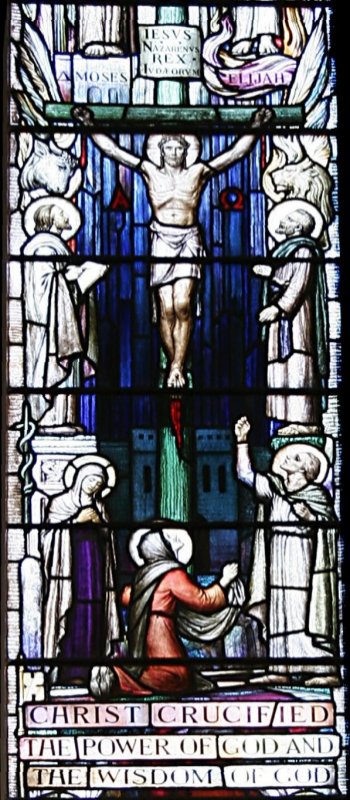
Centre Panel of the Central Light
The Crucifixion
The central panel of the central light is the final panel in our journey exploring the personalities and the stories of this War Memorial window, devoted to the many people and varieties of service that form the context for those who served, those who suffered, and those who died in the war: "Wisdom is justified of all her children". The other panels revolve around this central representation of the Crucified Christ. The Christ portrayed on the cross here is the radiant figure of Christ the King, transfigured in His glory. The blood flows from his hands and his feet, but He is "Christ crucified, the power of God and the wisdom of God", the Alpha and the Omega as the Greek letters on either side of his body show.
Christ here is surrounded by other figures and, although they are not named directly, it is clear who they are. On the left we have St Luke, writing, with his traditional symbol, the ox, above his head. Opposite him stands St Mark, identified by the lion over his head. Below St Luke stands Our Lady in a purple robe, with her head bowed, while opposite her stands St John, with his hand raised to his Lord. Between these figures, kneeling in supplication at the foot of the cross, is the figure of Mary Magdalene.
Maynard preached about this central panel in his sermon on the day the window was dedicated: February 6, 1949. He asked how Christ teaches wisdom, and what is the wisdom he teaches. To Maynard, the answer is to be found in the character of His living, not just in the completeness of His trust in God. He is unique in character, and that is why people of all stations of life turn to Him and are not disappointed. They find in Him what they need for their guidance in life, for their soul's satisfaction — "Kings and philosophers; rich men, poor men; men of all races and nations. Young men in their hopefulness, old men in their experience, strong men in power, the weak and the sick; all alike come to Him and learn wisdom and acknowledge Him to be the Lord. They find that He has been there before them, and so borne Himself that they can worship."
Maynard goes on to detail the fullness of Christ's life: "He has tasted Royalty, and he has tasted poverty, without that poverty getting Him down. He has known devoted friendship, but never let it entangle Him so as to turn Him by a hair's breadth from the fulfilling of God's will. He has tasted loneliness and ingratitude, without complaint to God, or the invasion of cynicism. He has tasted popularity without succumbing to the temptation to please the multitude. He has tasted injustice without railing at the law, or reviling the unjust judges. Even that could be turned to good account when borne with meekness, and with the committal of Himself to God."
"He stands alone, as one who has tasted life in its fullness, has been tempted in all points like as we are, as one who has enjoyed its riches, and plumbed its depths. And in every situation we see in Him the expression of that same 'Wisdom of God', if we live by which, we shall do well. His death was the consummation of the Wisdom of God in Christ. He is lifted up that all men may come to Him." In another sermon, Maynard quoted from the following hymn:
His be the Victor's Name
His be the Victor's Name
Who fought the fight alone;
Triumphant saints no honour claim;
Their conquest was his own.
By weakness and defeat
He won the Victor's crown;
Trod all the foes beneath His feet
By being trodden down.
He hell in hell laid low;
Made sin, He sin o'erthrew;
Bowed to the grave, destroyed it so,
And death, by dying, slew.
Bless, bless the Conqu'ror slain,
Slain by divine decree!
Who lived, who dies, who lives again,
For thee, my soul, for thee.
Samuel Gandy, 1780–1851.